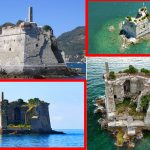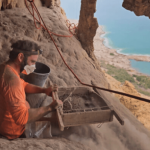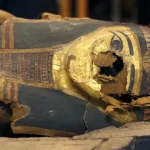Zadar Museum: Roman Shipwreck Glass Cargo.
Beneath the azure waters off the coast of the island of Mljet lies a silent witness to the ingenuity and craftsmanship of the ancient world—a Roman shipwreck laden with treasures from a bygone era. Among its cargo, fragments of history emerge in the form of chunks of raw glass, destined for the furnaces of ancient glassmakers. This maritime time capsule, dating back to the 1st-2nd century AD, offers a tantalizing glimpse into the thriving trade networks and sophisticated industries of the Roman Empire.
The discovery of the Roman shipwreck at Cape Glavat is a testament to the enduring allure of maritime archaeology and the mysteries that lie beneath the waves. Excavated with meticulous care and precision, the cargo of raw glass serves as a window into the bustling world of ancient commerce and the intricate processes involved in glass production.

In the ancient world, glass was a precious commodity, valued for its utility and beauty. From the humblest household vessels to the most exquisite works of art, glass permeated every aspect of daily life in the Roman Empire. The chunks of raw glass recovered from the shipwreck at Cape Glavat offer insights into the methods and materials used by ancient glassmakers, shedding light on a craft that has captivated human imagination for centuries.
Transported across the Mediterranean Sea, the cargo of raw glass reflects the interconnectedness of the ancient world and the far-reaching trade routes that crisscrossed the Mediterranean basin. From the bustling ports of the Levant to the imperial metropolis of Rome, goods flowed freely, enriching both merchants and consumers alike.

At the Zadar Museum of Ancient Glass, these fragments of history find a new home, where they are meticulously cataloged, studied, and preserved for future generations. Through careful analysis and scientific investigation, researchers seek to unlock the secrets held within these ancient artifacts, piecing together the story of their journey from the furnaces of ancient glassmakers to the depths of the sea.
The significance of the Roman shipwreck at Cape Glavat extends beyond the realm of archaeology and history. It is a testament to the resilience of the human spirit and the enduring legacy of ancient civilizations. As visitors stand before the artifacts recovered from the depths, they are transported back in time to an era of innovation and exploration, where the boundless curiosity of humanity knew no bounds.
In the quiet halls of the Zadar Museum of Ancient Glass, the fragments of raw glass from the Roman shipwreck stand as silent witnesses to the ebb and flow of history. Through their timeless beauty and historical significance, they serve as reminders of the enduring power of the past to inspire wonder and awe in the present.










